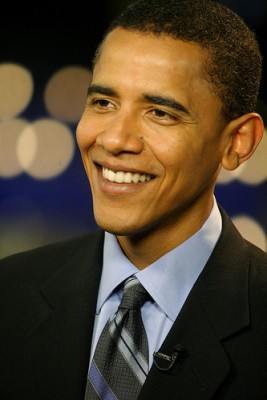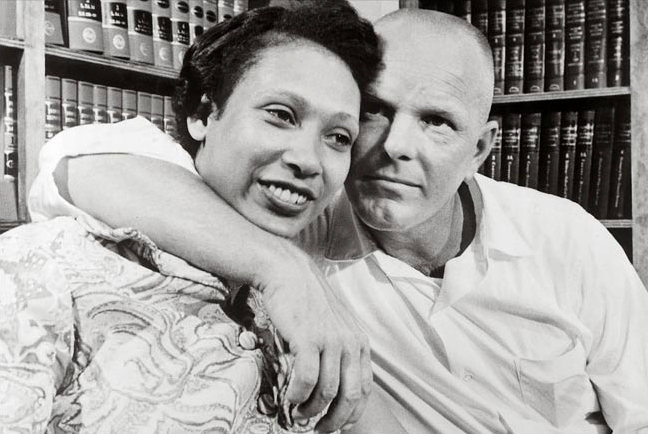How Far Have We Really Come from the "One-Drop Rule"?
- Black man, black woman, black baby
- White man, white woman, white baby
- White man, black woman, black baby
- Black man, white woman, black baby.
- - Public Enemy, Fear of a Black Planet
 There is no doubt that the election of Barack Obama as President of the United States is historic. But does framing him as America's "first black president" show that we have not come nearly as far as we'd like to think?
There is no doubt that the election of Barack Obama as President of the United States is historic. But does framing him as America's "first black president" show that we have not come nearly as far as we'd like to think?
The mainstream U.S. news -- and the majority of the American public, whether for or against him -- consider Barack Obama to be the first African American President. While he is certainly a member of the black community (and much more literally African-American due to his father being a Kenyan immigrant), he is also equally part of the white community. His mother was white. The grandmother who helped raise him (and whom he tragically lost to cancer on the eve of his election) was also white. But historically, and apparently to this day, to be black to any degree is to be exclusively black. Is our celebration of Barack Obama as the first black president proof that we haven't moved very far past the "one-drop rule"?
A Drop of Black, and You Never Go Back
The one-drop rule is the perception that any amount of non-white ancestral heritage makes a person non-white. But there is more than one interpretation of the concept. For some, the distinction is based on physical traits. If you appear to have black features, then you are black, whether it is more or less than 50% of your ancestry. Slightly differently, some believe that if there is even the most dilute black blood in a person's make-up, there will be a tell-tale sign of some kind that will prove the mixed heritage -- a birth mark, the shape of the crescent in the nail bed, or others.
But what we are seeing with the advent of Barack Obama as a national figure fits more within yet another third interpretation. Philosophy professor and author Naomi Zack defined it in her 1998 book, Thinking About Race. "One-drop rule: American social and legal custom of classifying anyone with one black ancestor, regardless of how far back, as black." I asked Zack for her comments about Barack Obama. She replied: "Why is someone with an African father and a white mother, who if race were real would be mixed race, considered 'Black?' Why is it not also absurd to refer to that person as 'a multi-racial African American'?"
In 1994, legal scholar Julie C. Lythcott-Haims wrote in the Harvard Civil Rights-Civil Liberties Law Review that the one-drop rule "still exists today; Americans who are part-Black are socially considered Black, and only Black by most Americans. ... The one-drop rule is so ingrained in the American psyche that Blacks and Whites do not think twice about it."
 In 1997, we saw Tiger Woods as a multiracial person being reduced to one facet of his identity. On Oprah Winfrey's show, he was asked if it bothered him to be referred to simply as African-American. He responded, "It does. Growing up, I came up with this name: I'm a 'Cablinasian'" (meaning Caucasian-Black-Indian-Asian). "I'm just who I am," Woods told Winfrey, "whoever you see in front of you." Sportswriter Ralph Riley wrote about Woods' background and the one-drop rule, without naming it. "Tiger's Asian heritage defines him as thoroughly as any other aspect of his makeup, although we tend to throw everyone brown and American with nice lips into the black blender."
In 1997, we saw Tiger Woods as a multiracial person being reduced to one facet of his identity. On Oprah Winfrey's show, he was asked if it bothered him to be referred to simply as African-American. He responded, "It does. Growing up, I came up with this name: I'm a 'Cablinasian'" (meaning Caucasian-Black-Indian-Asian). "I'm just who I am," Woods told Winfrey, "whoever you see in front of you." Sportswriter Ralph Riley wrote about Woods' background and the one-drop rule, without naming it. "Tiger's Asian heritage defines him as thoroughly as any other aspect of his makeup, although we tend to throw everyone brown and American with nice lips into the black blender."
It isn't just white culture that follows the one-drop rule, as Tiger Woods experienced in 1997. A May 1997 article in Time magazine looked at the reaction to Woods' statement on Oprah. "Kerboom! a mini-racial fire storm erupted. Woods' remarks infuriated many African Americans who hailed his record-setting triumph at the Masters as a symbol of racial progress but see him as a traitor. To them Woods appeared to be running away from being an African American ... In their rush to judgment, the fearful apparently never stopped to consider that Woods was not turning his back on any part of his identity but instead was embracing every aspect of it."
Fast-forward to November 2006 and in a 2006 Zogby International poll, 55% of whites considered Obama as biracial after being told that Obama's mother was white and his Kenyan father was black. Even more Hispanics -- 61% -- also saw Obama as biracial. But interestingly, 66% of the blacks polled classified Obama as black.
The October 23, 2006, cover story in Time magazine shows that we still have a hard time letting people of mixed racial backgrounds "embrace every aspect" of being "just who I am." In the story, titled "Why Barack Obama Could Be the Next President," reporter Joe Klein compared Obama to Colin Powell, and employed the one-drop assumption: "Powell and Obama have another thing in common: they are black people who -- like Tiger Woods, Oprah Winfrey and Michael Jordan -- seem to have an iconic power over the American imagination because they transcend racial stereotypes." Although Obama and Woods are both multiracial, Klein referred to them solely as black and even as "iconic" African-Americans.
What Race Is, and Isn't
Historically, race has been treated as a natural category for classifying human beings. The assumption that people can be grouped into distinct races has political overtones and motives. Activities such as slavery, domination, and oppression have been justified in large part by claims that those who dominate are inherently different (and superior) to those they dominate. Modern science, however, has shown that this system for classifying people has little if any basis in biology or genetics.
According to the current position on race of the American Anthropological Association, drafted in 1998, "The concept of race is a social and cultural construction... Race simply cannot be tested or proven scientifically ... It is clear that human populations are not unambiguous, clearly demarcated, biologically distinct groups. The concept of 'race' has no validity ... in the human species." According to the U.S. Census Bureau, race is "self-identification by people according to the race or races with which they most closely identify. These categories are sociopolitical constructs and should not be interpreted as being scientific or anthropological in nature. Furthermore, the race categories include both racial and national-origin groups." When speaking of human genetic variations, scientists today study "populations" rather than "races," a more precise term that avoids the misleading assumption that superficial characteristics such as skin color group automatically with other characteristics such as intelligence or character. In everyday life, however, "race" is still the most commonly used term and the most widely accepted concept.
Barack Obama's life experience makes him a particularly interesting case study in the problems inherent in trying to classify people by race. Obama is the son of a Kenyan man who came to study in the U.S. He was born and raised by his white maternal family in multiracial, multiethnic Hawai'i, and spent a portion of his young life living in Indonesia. He is "black" in the sense that he has an African father, but his experience growing up is quite different from that of a "typical" African American. Of course, the idea that there is a "typical" African American experience is itself rather suspect. Generations have passed since the first Africans arrived on American shores, and many African Americans have a variety of non-African ancestors with Native American, Caucasian or other roots. Ironically, therefore, Obama's mixed ancestry may be the most "typical" characteristic he shares with other African Americans.
We're Not There Yet
 Even when Obama's mixed racial background is mentioned, the one-drop assumptions and default terms come into play. In a November 8, 2008 article titled "'Mutts Like Me' -- Obama Shows Ease Discussing Race," writer Alan Fram focuses on a comment that the president-elect made about what type of puppy his girls would bring to the White House with them. "Obviously, a lot of shelter dogs are mutts like me," Obama said. Fram seems to be getting to the heart of the matter, saying "The message seemed clear -- here is a president who will be quite at ease discussing race, a complex issue as unresolved as it is uncomfortable for many to talk about openly. And at a time when whites in the country are not many years from becoming the minority." However, old habits die hard. Fram also says, "By now, almost everyone knows that Obama's mother was white and father was black, putting him on track to become the nation's first African-American president."
Even when Obama's mixed racial background is mentioned, the one-drop assumptions and default terms come into play. In a November 8, 2008 article titled "'Mutts Like Me' -- Obama Shows Ease Discussing Race," writer Alan Fram focuses on a comment that the president-elect made about what type of puppy his girls would bring to the White House with them. "Obviously, a lot of shelter dogs are mutts like me," Obama said. Fram seems to be getting to the heart of the matter, saying "The message seemed clear -- here is a president who will be quite at ease discussing race, a complex issue as unresolved as it is uncomfortable for many to talk about openly. And at a time when whites in the country are not many years from becoming the minority." However, old habits die hard. Fram also says, "By now, almost everyone knows that Obama's mother was white and father was black, putting him on track to become the nation's first African-American president."
Should embracing the multiracial background of people like Barack Obama or Tiger Woods take away from the pride and sense of accomplishment that different communities take in his achievements? Is it really less of a victory for blacks if Obama's mixed race is acknowledged and celebrated? In a November 10, 2008, article for Salon.com titled "Our Biracial President," James Hannaham wrote, "Obama's biracial. ... This is not to say that he hasn't received some of the same treatment as black Americans, or that he is not welcome among them, or that people should denigrate his need to make his background understandable to people who think that 'biracial' means a type of airplane. It suggests something far less divisive. It means that black and white people (not to mention other ethnicities chained to the binary idiocy of American race relations) can share his victory equally."
 In 1967, there were still sixteen U.S. states that had laws on the books banning interracial marriage. That isn't a typo -- 1967. It was in that year that the US. Supreme Court unanimously struck down laws banning interracial marriages with these words: "The freedom to marry, or not marry, a person of another race resides within the individual and cannot be infringed on by the State." Barack Obama's parents met, married, and gave birth to him in Hawai'i in the early 1960s. It is a matter of chance that they were not in one of the states where interracial marriage and sex was illegal. In addition, the 2000 U.S. census was the first one in which respondents could choose to identify themselves as belonging to more than a single race. Given that recent history, perhaps we could all celebrate how far we have come by electing a biracial President.
In 1967, there were still sixteen U.S. states that had laws on the books banning interracial marriage. That isn't a typo -- 1967. It was in that year that the US. Supreme Court unanimously struck down laws banning interracial marriages with these words: "The freedom to marry, or not marry, a person of another race resides within the individual and cannot be infringed on by the State." Barack Obama's parents met, married, and gave birth to him in Hawai'i in the early 1960s. It is a matter of chance that they were not in one of the states where interracial marriage and sex was illegal. In addition, the 2000 U.S. census was the first one in which respondents could choose to identify themselves as belonging to more than a single race. Given that recent history, perhaps we could all celebrate how far we have come by electing a biracial President.
Judith Siers-Poisson is the Associate Director of the Center for Media and Democracy (www.PRWatch.org)





Comments
Not there yet
I'm not safisfied by the way international media (and the GOP) keep focusing this one side of an Historic win : let us not forget the first meaning of these glorious elections.
That said, I'm overwhelmed by pride for America and shame for my own country, France, whose fantastic diversity is not reflected in politics nor even in the media.
______________________________________________________________________________________
Stephane MOT -
blogules and other Weapons of Mass Disinformation
_____________________________________________
one drop rule
The spin of the week is the blame game of not getting over the one drop blood bull, when in fact it is Obama himself that states he is black man. I heard him in an interview and he said I identify myself as black, I have a black wife and I have black children. He is the one that is in denial.
quick question.. I am a
quick question.. I am a black person, I have a white friend who says she has 20% black in her. Looking at her you can tell she is white. She has been saying this for the longest time now but has never shown any solid proof. Im confused
Anthropologically speaking............
Human biological "races" simply do not exist.
"Race" is a social concept born from the African Diaspora back in the 1400's during European Colonialism.
Human biological variation is very real and we, as scientists, try to understand this variation using the forces of evolution including Darwin's mechanism of Natural Selection (which results in adaptation).
"race" does not even explain the distribution of differences in skin pigmentation. Some of the darkest populations on earth are not African (Dravidians of India and native Australians). Latitude and ultraviolet radiation explain the variations in skin pigmentation.
Sickle-cell is not an African disease. It is found in other populations and it can be explained scientifically as an adaptation to malaria.
No one human population is more athletic than any other. People who grow up in the mountains of Ethiopia and the high plains of Kenya have adapted since birth to high altitude stress by developing greater aerobic capacities.
and so on............
So, why the myth making? We humans are failing to adapt to global over-population generating crowding stress.
Racism is very real and along with the other almost countless forms of social discrimination like sexism, ageism, religionism, sexual orientationism, political philosophy-ism, nationalism, and so on- these are increasing because of crowding stress. And we will simply replace one form of discrimination with another- maybe how we crack open our eggs?
Humans have been over-populating this planet to the extent that there will never be Peace on Earth.
(sorry to ruin your new millennium!)
Fun side-note
Not to nitpick but ""Black man, black woman, black baby /
White man, white woman, white baby /
White man, black woman, black baby /
Black man, white woman, black baby."
Public Enemy, Fear of a Black Planet"
was actually Eddie Murphy stand-up played in a Public Enemy song :-)
Check me out on myspace! http://www.zmag.org/zspace/stevehunt
Great Article
I have always felt that racism has its roots in survival. Since the beginning of man one of the first things we learned was that our survival was more successful in groups rather than individuals. belonging to a group became crucial and group identity an essential tool. The easiest way to indicate or form the group was/is visual cues. skin color the most Obvious, as the ages have progressed we have develped many others...music tastes,hairstyles,choice of material objects,dress and clothing,religious beliefs are a few identifiers. growing up can be especially traumatic if one is not accepted in a group...the power of group dynamics can not be under estimated. Education and time are neccessary to help us evolve to a social higher state...thus patience and tolerance are of utmost importance in our gateway times. Fear is a dangerous subversive tool used by the unscrupulous for thier own agendas.
great article ....thank you
http://massmediacontrol.blogspot.com
Obama self-identifies as black
Your point about the arbitrary one drop rule is well-taken.
However, part of the reason society classifies Obama black is because he proudly identifies himself as a black man. He moved to Chicago, organized in majority-black communities, married a black woman, joined a black church, wrote eloquently in his memoirs about his search for identity, and so on.
If Obama had chosen to do so, he could have defined himself as white or biracial, but he didn't. I think that's part of the reason why he's an especially powerful symbol of blackness. Obama chose to embrace his black identity, even though it might have been easier to present himself another way.
http://majikthise.typepad.com
Viewing Obama
First of all, very well done with the article.
Leaving aside that likely all humans have sub-Saharan African ancestry, even if you only go back five hundred years “black blood” was and continues to be dispersed throughout various groups. In some members of a group this will be highly evident, visibly speaking, and in other members this will not be evident at all. Even though this is easily verifiable, these groups are not one-dropped as a whole by those in the U.S.
Ask yourself, what if Obama looked exactly the same but both his parents were immigrants from a country in Latin America? What if he mainly connected to the culture of that country and to the broader Latino culture?
What if Obama had pale pink skin, blond hair, blue eyes, and his great-great-great grandmother was a slave? What if his wife was a Filipino-American and Obama was now somewhat connected to Filipino culture but mostly connected to mainstream American culture?
Play around with the variables. What would your reaction be as Obama stood on stage and gave his victory speech in Grant Park? Would it change the historic nature of the moment for you?
Bottom line, it is hardly as simplistic as many make it out to be.
One-drop rule story
I was intrigued to read your article. But I take issue with its foundation. If we are arguing that Obama should not be considered black because his mother is white, we are then by nature arguing there is such a thing as pure black. And then by extension we are saying that only pure black people warrant acknowledgment. Who are they? Where do such people exist? Possibly somewhere in Africa, but there is certainly no "pure" black race in America.
Yes, Obama and many Americans are of mixed racial heritage. But we have inherited, unfortunately, an unfair and often uncomfortable system colored by an ugly history and still ugly current-day reality. It was not long ago a person of Obama's or my own skin color could not vote, or marry a white person, much less run to be president. The only community to love and nurture dark-skinned people were dark-skinned people. The only community to support, educate and encourage dark-skinned people were dark-skinned people.
Obama is a dark-skinned person with African physical characteristics. He will never be mistaken for anything other than that. That is the reality - not the drop of blood. His white drop of blood isn’t dominating his physical appearance. His black blood is.
Yes, the one-drop rule is egregious and ignorant. And while it's a regrettable reality of our history and present, it’s not the prevailing influence in how Obama is perceived. It’s his physical traits and how America reacts to those traits. If he were walking down the street and you needed to describe him you would say he was about six feet tall, wearing a suit - oh and he was a black man with a close cropped haircut. You wouldn’t say he was what appeared to be a mixed-race man. Not a half-white, half-black man. You would say a black man. That does not disrespect his heritage. It does not imply racism on the part of the describer. It’s just a fact.
So of course, at this historic moment black people have embraced Obama, who's very reflection they see looking back at them in the mirror.
People of mixed race often walk a fine line between family members and segments of society. To deny a side of the family is to deny oneself. Obama openly embraces both. But know that he looks in the mirror and sees the face of a dark-skinned man who can be the target of hatred and discrimination solely for the color of his skin – and he knows that. He knows that because he is in America and he is a black man.
He also knows that he is the first dark-skinned – black person – to be elected president of the United States of America. He carries with him the hopes and expectations of his family’s white and black ancestors as he steps into his role as the leader of our nation.
"The edge is where the change occurs" - S.B.
One-drop rule story
S.B. that was very well said thank for the lesson I have been trying to get people that I talk to to see that point but they refuse to again thanks for that lesson.